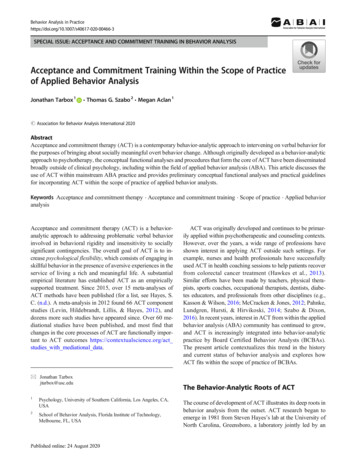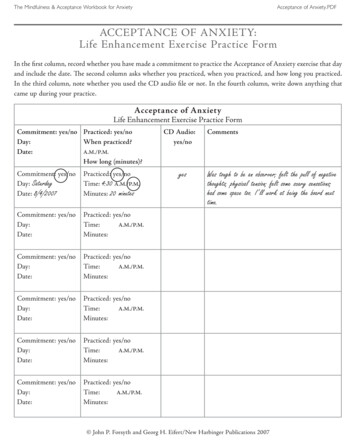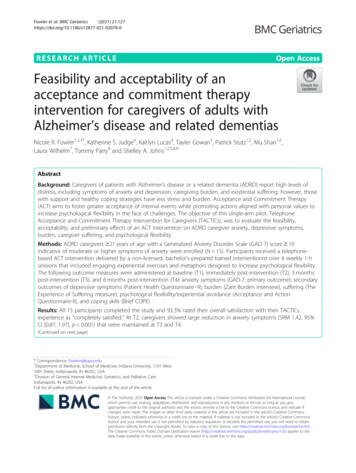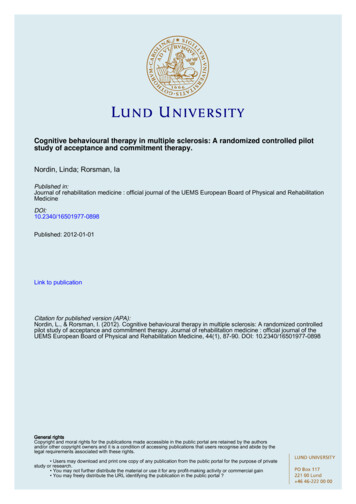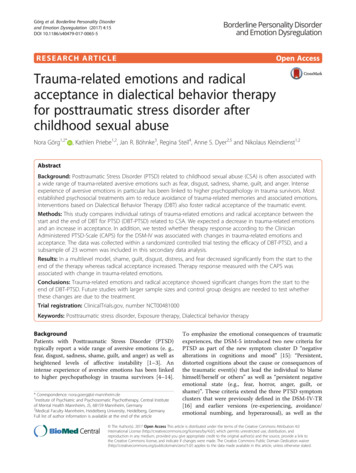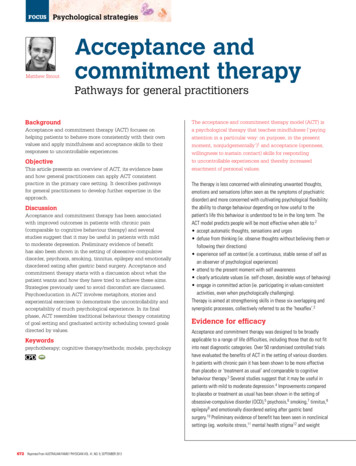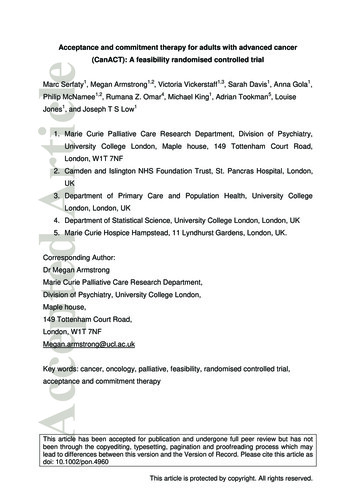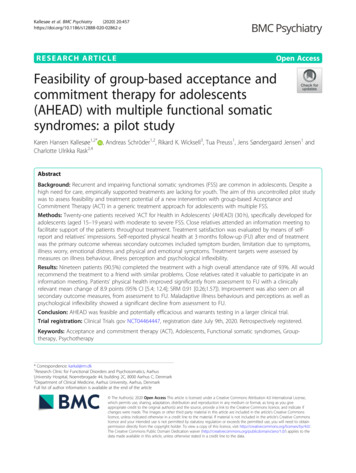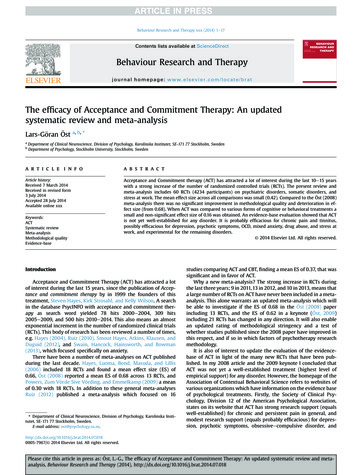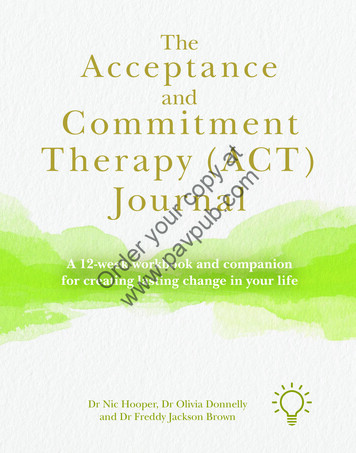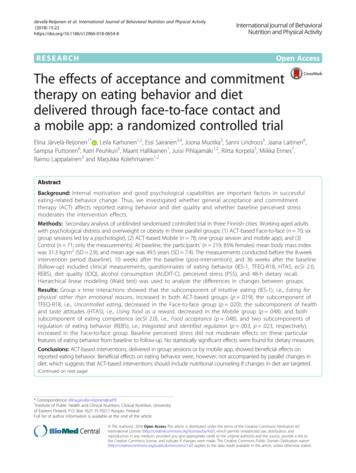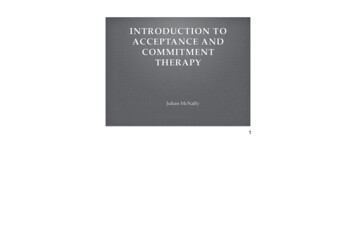
Transcription
INTRODUCTION TOACCEPTANCE ANDCOMMITMENTTHERAPYJulian McNally1
PROGRAM OUTLINEAbout ACT: Definition,Research, Differences40 minutesHow does ACT work?45 minutesHow to do ACT210 minutesHow to learn moreabout ACT15 minutes2“How does ACT work?” will bleed into “How to do ACT” becausesometimes demonstration trumps explanation.
WHAT IS ACT?Behaviour-FocusedTransdiagnosticBroad in scope3Acceptance and Commitment therapy is a behaviour-focused, transdiagnostic model of therapy that is broad inscope and uses mindfulness and behaviour change processes to enhance clients’ engagement, vitality andsense of life purpose.Behaviour-focused: The therapist detects and assesses maladaptive client behaviours and aims to influencethem to be more consistent with client values. We’re interested in what clients are doing (and not doing), howthe doing relates to environmental and historical contingencies and what function the behaviours have.Transdiagnostic: As we’ll see when we look at the research, it applies to a wide variety of clinical and nonclinical problems. What this means is that the basic model encompasses principles that explain a broad rangeof pathological presentations. And in relation to diagnosis/ assessment, we examine behaviour in its contextand for its function. Outside the context we can’t know much. Without knowing the purpose or function of thebehaviour, we can’t say whether it’s healthy (functional) or not.Broad in scope: the same model of behaviour and communication applies to the researcher, the therapist, the
MAJOR RESEARCHFINDINGS Treatment as usualBroad range of problemsResults consistent withtheory (mechanism iseffective)Effects are longer lasting4Examples: Chronic pain and pain tolerance analogues, panic disorder and panic symptom analogues, epilepsy,schizophrenia, work-site stress, stigmatisation of clients and counsellor burnout, drug addiction. See the ACTPack for details.Consistent with theory: Positive outcomes are mediated by acceptance, negative outcomes mediated by nonacceptance, fusion/believability of thoughts and remoteness from values.In more than 40 studies with nearly 10,000 participants, psychological flexibility accounts for 16 to 33% ofmost psychological outcomesThere is evidence that the effects of negative thoughts, difficult feelings, maladaptive coping, emotionalresponse styles, cognitive reappraisal, and perceived controllability, are all partially or fully mediated bypsychological flexibility
5This is some of the range of problems we’ve found ACT effective with.Now let’s look at some findings relevant to anxiety - both mediationand outcome studies included. Mediation because we want to makesure the processes we claim are relevant actually are. [Helps uscounter the non-specific factors argument.]
ACCEPTANCE & ACTIONQUESTIONNAIRE (AAQ-I, 9 ITEM)1. I am able to take action on a problem even if I am uncertain what is the right thing todo.2. I often catch myself daydreaming about things I’ve done and what I would dodifferently next time.3. When I feel depressed or anxious, I am unable to take care of my responsibilities.4. I rarely worry about getting my anxieties, worries, and feelings under control.5. I’m not afraid of my feelings.6. When I evaluate something negatively, I usually recognize that this is just areaction, not an objective fact.7. When I compare myself to other people, it seems that most of them are handlingtheir lives better than I do.8. Anxiety is bad.9. If I could magically remove all the painful experiences I’ve had in my life, I woulddo so.6Although the AAQ is often said to be a measure of experiential avoidance, the originalitem pool focused on all major ACT processesThese 9-22 items (version II) cover a wide range of issues, including acceptance,defusion, and action.The AAQ I and the soon to be released AAQ II seem to be measures of psychologicalflexibility more generally, emphasizing the parts of the model that we can tap easilywithin the existing language community.There are now 27 studies using the AAQ, involving 5,616 participants, So what is theAAQ telling us? [click]
7
AAQ AND PATHOLOGYMEASURESAll reported correlations are positive for the modelBDI (8 studies).50SCL 90 (3 studies).53BAI or STAI (3 studies) .49GHQ (3 studies).40Overall effect size.42 – (CI: 0.40– 0.44)8There are also now pathology-specific versions of the AAQ (e.g. foreating disorders and chronic pain). Changes in scores on themmediate outcomes in those studies too. Now let’s look at somepathology analogue studies.
ACCEPTANCE AND EXPOSURELevitt, Brown, Orsillo, & Barlow, Behavior Therapy, 200460 individuals with a primary diagnosis of panicdisorder with or without agoraphobia randomlyassigned to one of three groups (10 min audiotape):Acceptance, Suppression, Control (irrelevantdistraction)15-minute 5.5% CO2 challenge (panic provocation)9This is a typical panic disorder analogue, this time done with subjectswho fit the diagnosis. Watch what happens.
10So anxiety is lower under Acceptance than Suppression, ANDwillingness increases.
ACCEPTANCE VS. CONTROL TECHNIQUESWITH PAIN TOLERANCEHayes, S. C., Bissett, R., Korn, Z., Zettle, R. D., Rosenfarb, I., Cooper,L., & Grundt, A. (1999). The Psychological Record, 49(1), 33-47.3 groups of subjects:ACT rationale plus acceptance and defusion practiceCBT rationale plus practiceInformation about pain (placebo control)Cold pressor task (up to 5 minutes)11cold pressor water at 1 deg C. “You may remove your hand at anytime, but stay as long as you can”.CBT rationale was ‘distract yourself from pain by thinking of a pleasantexperience’. Appeals to logic and ‘common sense’ yes?ACT rationale was ‘thoughts and feelings don’t control actions, peopledo’ and ‘you can’t successfully control thoughts and feelings anyway’.
Cohen’s d, Acceptance vs. Cognitive 0.5, Acceptancevs. placebo 0.9712Note: These are individual subject scores.
COPING WITH PSYCHOTIC SYMPTOMSBach & Hayes, 200280 S’s hospitalised with hallucinations and/ordelusions randomised to either ACT or TAU3 hours of ACT; all but one session in-patientACT intervention focused on acceptance anddefusion from hallucinations / delusions13What is that creates anxiety for the psychotic patient? Isn’t it the beliefthat the delusional experiences might be real? What do you do aboutthat? Avoid contact with others, medicate, pace and talk to reassureyour self, otherwise engage in a struggle with your experience. Mostfearful thing is not to HAVE the delusion but to BELIEVE it.Will explain Defusion and Acceptance in the next section.
14Note:Longer duration before hospitalisation for patients in the ACTtreatment. So any differences between groups - e.g. maybe TAU was amore severe group, less medication? No to both and in fact, HIGHERfrequency of symptoms for ACT group. So what mediates it believability of delusions /hallucinations.Recent replication by Gaudiano and Herbert has shown similar results- 55% of TAU rehospitalised at 4 months vs. only 20 % for ACT group.What about against pharmacological interventions?
15ACT for smoking cessation: think about the savings in medicaltreatment and suffering if you keep just an extra 10% of people offsmokes for a year.
Changing Counsellor Attitudes ToRecommending ESTsVarra, Hayes, Roget & Fisher, 200859 drug and alcohol counsellors randomly assigned to:๏One day ACT workshop focused on defusing from thepsychological barriers to learning new treatmentapproaches, and acceptance of the emotions they bring up๏One day workshop on matters not linked to empiricallysupported treatments e.g. EAP policies (Control condition)๏Both groups then do a two day educational workshop onempirically supported treatments in the drug and alcoholarea focusing particularly on the use of agonists andantagonists16This is important work because counsellors should be doing whatworks. If there are perceived barriers to doing that, it would be helpfulto have an intervention that overcomes those barriers.
171. Who perceives the barriers? The ACT group acknowledges thebarriers, but fair enough, they just did a day’s training focused on(defusing from) them.2. although the ACT group starts off believing the barriers are morereal than the control group, the intervention ‘works’ in reducingbelievability in the ‘realness’ of them.3. What difference does this make? [Click] The ACT group reportsgreater willingness to use the ESTs. But then experimental subjects tellyou what they think you want to hear. What we want to know is whatdifference in behaviour happened (cf. changing attitudes re prejudice,
HOW IS ACT DIFFERENT?Philosophy: FunctionalContextualismDerivation: Science thenpracticeExamples: CBT, SFT18Philosophy. Compared to materialist philosophies that inform most other approaches to science and practice(e.g. mechanism), RFT does not pre-suppose the existence of mechanisms (like ‘mind’ and ‘causes’). Focusinstead is what works and how it works - search for effective components and a model that allows forprediction and influence with precision, scope and depth.Science then practice. Hayes, Zettle and colleagues sought a model that works from the ground up toencompass all of human behaviour - including emotions and cognition as a form of behaviour rather thanhaving to treat it with separate rules.Other approaches aim to change internal experience, whereas we aim to change the context within which theyoccur - values & workability.Examples:oTo CBT: accept vs. dispute thoughts, work on Ctʼs relationship with thoughts not with their content, feelings not evaluated asgood/bad. MBCT/MBSR - accept to get over.o To psychodynamic: theoretical level - same as per behaviour therapy – no need for explanatory phenomena that addnothing (e.g. transference behaviour), clinical level – attention to values not meaning
Contact with the PresentMomentValues, Purpose &MeaningAcceptance & ed ActionsTranscendent Sense ofSelf/ Self As Context“HEXAFLEX”ACT Model of Effective Living19Values are “are verbally constructed global desired life consequences”.Global because they are always available (for our attention), not somuch desired as approved or appreciated for the pursuit itself not forthe outcome of the pursuit. (Hank Robb)
Dominance ofConceptualised Past orFeared FutureLack of Values Clarity orContactExperiential yInaction or DisorganisedActivityFusionAttachment to “Storied”or Conceptualised Self“INFLEXAHEX”ACT Model of Psychopathology20
Mindfulness & AcceptanceProcessesBehaviour ChangeProcessesContact with the PresentMomentAcceptance & WillingnessValues, Purpose &MeaningPsychologicalFlexibilityDefusionCommitted ActionsTranscendent Sense ofSelf/ Self As Context“HEXAFLEX”ACT Model of Effective Living21
Sensory ExperienceStrugglingw/SufferingValued LivingMental ExperienceI-GRID - KEVIN POLKEven Simpler Model of ACT Processes22Healthy living Acceptance of and response to sensory experience, with actions guided by values.Pathology Fusion and over-involvement with Mental Experience and actions directed into struggling withsufferingThen you just have the client do a Life Manual (Handout 3) and identify current and future actions as SwS or VLIf time - do this:Simply draw The Grid for your client and explain that to the right are behaviors or actions toward values, importantthings like health, relationships, etc. To the left are behaviors away from unwanted mental experiences like anxietyand depression. Explain that all humans do both kinds of behaviors. Above the left line write the following:I for .actionsufferingI for .actionvalue
C O N TA C T W I T H T H E P R E S E N T M O M E N TExercise 123BREAK!
WHEN TO USE AND WHEN NOT TO USEMINDFULNESS EXERCISESYou feel stressed orstuckClient is agitated,“mindy” or circularPsychosisSeverely drug-affectedUnsafe environment,including prior traumaGive yourself timeWhen your client has apulse!241. Stressed? Allows you to get present and choose from alternatives how to respond best.2. Agitated, “mindy” or circular (going round in circles)? Gives them a chance to calm down - grounds them.Helps them defuse if “mindy” or contact observing self if they’re retelling/ re-living their story.3. Give yourself time? Allows you to make better decision. We need only 1, not 2 agitated people in order tohave a counselling situation. We need 2 non-stressed individuals in order for effective learning to take place.4. Pulse? First do no harm, and except for the following caveats, anyone will benefit.5. Psychosis - e.g. auditory or command hallucinations - may be unable to distinguish sounds from your voice,your voice from hallucinated voices. Try with eyes open and more tactile commands - you can feel the phone,etc. “tell me what you can see - describe it in detail”.6. Drug-affected? May nod off or have difficulty following. Not harmful, just not helpful.7. Unsafe environment? Safety is first priority. If intrusive re-experiencing is happening, may not be able tohold them over the phone. Probably need assessment if acute, but can ground with instructions for Psychosis ifthey will stay on the line.
Contact with the PresentMomentValues, Purpose &MeaningAcceptance & ed ActionsTranscendent Sense ofSelf/ Self As Context“HEXAFLEX”ACT Model of Effective Living25Workability & Values to start. Identify motivation for change:1. Workability - fed up with getting nowhere, open to trying a different approach even if it doesn't make sense.Quicksand. Finger-cuff. Give examples of Workability questions: What have you been struggling with? Whathave you tried? How has that worked? And yet it’s still there 2. Values - Life beyond symptoms, struggle and relief.Examples of Values questions: MQ – life without this problem. Where was your life headed before this camealong? What is this stopping you from doing? Why is that important to you?
YOUR TURN!Pair up - one is “A” the other is “B”Decide individually ifyou’ll be a client orconsult on a clientUse the “Guide to initialACT session” forquestions - 2, 3 & 4If being a client, yourpartner is the counsellorObserve and resist urgeto “fix” or make betterIf consulting, yourpartner is yoursupervisorHasten slowly26
“PAIN IS MANDATORY,SUFFERING IS A CHOICE”Julian McNally (I think)27vs. inevitable and optionalHere’s what Pain looks like.And here’s what our minds do to create suffering. Think of thedemons as thoughts.
“IF YOU’RE UNWILLING TO HAVE ITYOU’VE GOT IT”Hayes, Wilson & Strosahl28The essence of Acceptance and Willingness is that if you’re willing to have it, itprobably won’t bother you. If you’re unwilling to have it you get to keep it and sufferwhile keeping it.Now, try not to think about a flying pink elephant. [Click] - this is what I want you notto think about.How did you go? [“What are the numbers?” and “Mary had a little.” if necessary.]Why Accept? Not to get rid of, but in service of pursuing valued direction.
BREAK29
DEFUSIONCan you have your thoughts and feelings for whatthey are and not for what they say they are?30Sometimes your thoughts are like bullies. If you pay them heed, you end up going in adirection that’s not truly yours.Really, though, they just show up for the ride. They can say turn left and you can stillchoose to turn right.[If needed, demonstrate other defusion exercises.]
“I think that.”“I’m having the thought that.”“I notice I’m having the thought that.”This isunbearableI noticethose thoughts arethere again313 Step defusion of troublesome thoughts1. I think that this suffering is unbearable2. You could say though, that I'm having the thought that this suffering is unbearable.3. You could also NOTICE that you are there having the thought.4. It looks like the thought appears out of nowhere. Just like when you open your eyes,there is the world.5. As soon as that “unbearable” thought appears, so does everything else associatedwith it. [RFs]6. But there is a mind there having the thoughts. In a sense you contain them, so youare not them.7. .and can observe your mind having them. [Then go on to choose value-consistentactions in their presence.]
LemonLemonLemonLemon32Think about a sour, juicy lemon cut in half. Imagine squeezing acouple of drops of juice onto your tongue and feeling the sharp bite ofthat sourness. who’s salivating. Now say “Lemon” x 30 secs. Whathappened?Exercise is not used to defuse, but to demonstrate that it’s possible todisplace the derived stimulus functions of saying “lemon” with directones
SIMPLE SELF-ASCONTEXT METHOD1.Notice an experience2.Notice that you’re noticing it33.or for 2, notice that you’re having it. Where is the you that is havingit?Try this now
Recontextualising the ProblemThe Life I’m left ightUnloveableNeed therapy!What I want my lifeto stand ghtUnloveableNeed therapy!34What you pay attention to grows. [Demonstrate if needed]. This is whythe gratitude diary works - focuses attention on what the personvalues most in life. Do you want life to be what you have left onceyou’ve dealt with the grey stuff?So the question for the client is “What are the patterns of action thatare going to be consistent with that white space in your life?” [Rainervideo - then H6]
HOW TO LEARN MOREJoin ACBS for USD1.00! at www.contextualpsychology.orgJoin the listserves at Yahoo! Search for “groups” and“acceptanceandcommitmenttherapy”Stay tuned to these for the ACT-ANZ Conference 13-15November at Melbourne UniversityRuss Harris’ website, workshops and newsletter atwww.actmindfully.com.auMy website and workshops (2010) at julianmcnally.com35ACBS get resourcesListserve join the conversation, belong to a communityConference 1 & 2 but more soRuss & Julian training and supervision
Acceptance and Commitment therapy is a behaviour-focused, transdiagnostic model of therapy that is broad in scope and uses mindfulness and behaviour change processes to enhance clients' engagement, vitality and sense of life purpose. Behaviour-focused: The therapist detects and assesses maladaptive client behaviours and aims to influence
